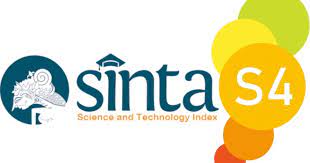Flipped Learning Instruction and Pragmatic Competence: A Case of English for Accounting Students
DOI:
https://doi.org/10.22219/englie.v2i1.14646Abstract
Twenty-first century English language teaching is the witness of advanced Information and Communication Technology (ICT). Integrating digital technologies in English teaching activities is a prerequisite to enhance learning efficacy and achieve the goal of English communicative competence. Hence, this study examines the impact of flipped learning instruction on pragmatic competence of a group of English for specific purposes students’, i.e. English for Accounting. This pre-experimental study was conducted in ten meetings by involving 36 English for Accounting students of a public university in Surakarta Indonesia as the participants. Drawing on a Discourse Completion Test (DCT) and Focus Group Discussion (FGD), the results portrayed that there was a significant difference between the results of pre-test and post-test on DCT, meaning that the students’ pragmatic competence significantly improved after participating in the flipped learning instruction. An FGD was further conducted to reveal the students’ attitudes about the practice of flipped learning and the results indicated that they positively perceived the implementation of the teaching model in English for Accounting class. These results contribute to offering fruitful insights for teachers and future researchers about the practice of flipped learning instruction in English language teaching, particularly in the context of English for specific purposes.
Keywords: English for Accounting, Flipped Learning, Pragmatic Competence
Downloads
References
Afrilyasanti, R., Cahyono, B. Y., & Astuti, U. P. (2017). Indonesian EFL Students’ Perceptions on the Implementation of Flipped Classroom Model. Journal of Language Teaching and Research, 8(3), 476. https://doi.org/10.17507/jltr.0803.05
Alwehaibi, H. O. (2015). The Impact Of Using YouTube In EFL Classroom On Enhancing EFL Students’ Content Learning. Journal of College Teaching & Learning (TLC), 12(2), 121–126. https://doi.org/10.19030/tlc.v12i2.9182
Alzeebaree, Y., & Yavuz, M. A. (2017). Realization of the speech acts of request and apology by middle eastern EFL learners. Eurasia Journal of Mathematics, Science and Technology Education, 13(11), 7313–7327. https://doi.org/10.12973/ejmste/79603
Bergmann, J., & Sams, A. (2012). Flip your classroom: Reach every student in every class every day. International society for technology in education.
Blum-kulka, S., & Olshtain, E. (1984). Requests and apologies: A cross-cultural study of speech act realization patterns (CCSARP). Applied Linguistics, 5(3), 196–213. https://doi.org/10.1093/applin/5.3.196
Bonk, C. J., & Graham, C. R. (2012). The handbook of blended learning: Global perspectives, local designs. John Wiley & Sons.
Cahyono, B. Y., & Mutiaraningrum, I. (2015). Indonesian EFL Teachers’ Familiarity with and Opinion on the Internet-Based Teaching of Writing. English Language Teaching, 9(1), 199. https://doi.org/10.5539/elt.v9n1p199
Celce-Murcia, M., Dörnyei, Z., & Thurrell, S. (1995). Issues in Applied Linguistics Authors Model with Content Specifications. Issues in Applied Linguistics, 6(2), 5–35.
Chen Hsieh, J. S., Wu, W.-C. V., & Marek, M. W. (2017). Using the flipped classroom to enhance EFL learning. Computer Assisted Language Learning, 30(1–2), 1–21.
Chen, Y., Wang, Y., & Chen, N.-S. (2014). Is FLIP enough? Or should we use the FLIP model instead? Computers & Education, 79, 16–27.
Gatcho, A. R. G., & Hajan, B. H. (2019). “Check Your Face(Book) on Page…”: Unpacking the Pedagogical Potentialities of English Teachers’ Wall Posts. Lingua Cultura, 13(1), 1. https://doi.org/10.21512/lc.v13i1.5253
Haghighi, H., Jafarigohar, M., Khoshsima, H., & Vahdany, F. (2019b). Impact of flipped classroom on EFL learners’ appropriate use of refusal: achievement, participation, perception. Computer Assisted Language Learning, 32(3), 261–293. https://doi.org/10.1080/09588221.2018.1504083
Hasanudin, C., & Fitrianingsih, A. (2018). Flipped Classroom Using Screencast-O-Matic Apps in Teaching Reading Skill in Indonesian Language. International Journal of Pedagogy and Teacher Education, 2, 16–151.
Hazaymeh, W. A., & Altakhaineh, A. R. M. (2019). The effect of flipped classroom instruction on developing emirati EFL learners’ pragmatic competence. International Journal of Learning, Teaching and Educational Research, 18(10), 89–111. https://doi.org/10.26803/ijlter.18.10.6
Kasper, G., & Schmidt, R. (1996). Developmental issues in interlanguage pragmatics. Studies in Second Language Acquisition, 18(2), 149–169.
Krisnawati, E. (2011). Pragmatic competence in the spoken english classroom. Indonesian Journal of Applied Linguistics, 1(1), 105–115. https://doi.org/10.17509/ijal.v1i1.102
Lee, J. S. (2019). Informal digital learning of English and second language vocabulary outcomes: Can quantity conquer quality? British Journal of Educational Technology, 50(2), 767–778. https://doi.org/10.1111/bjet.12599
Lee, J. S., & Drajati, N. A. (2019). English as an international language beyond the ELT classroom. ELT Journal, 73(4), 419–427. https://doi.org/10.1093/elt/ccz018
Lockwood, R. B. (2014). Flip it!: Strategies for the ESL classroom. University of Michigan Press.
McLaughlin, J. E., White, P. J., Khanova, J., & Yuriev, E. (2016). Flipped classroom implementation: a case report of two higher education institutions in the United States and Australia. Computers in the Schools, 33(1), 24–37.
Muthusamy, P., & Farashaiyan, A. (2016). Situational Variations in Request and Apology Realization Strategies among International Postgraduate Students at Malaysian Universities. English Language Teaching, 9(3), 181. https://doi.org/10.5539/elt.v9n3p181
Mutiaraningrum, I., & Nugroho, A. (2020). Social construction of knowledge in synchronous text-based discussion during English language learning. Journal on English as a Foreign Language, 10(2), 315–336. https://doi.org/10.23971/jefl.v10i2.1934
Nartiningrum, N. & Nugroho, A. (2020). Online Learning amidst Global Pandemic : EFL Students ’ Challenges , Suggestions , and Needed Materials. English Franca: Academic Journal of English Language and Education, 4(2), 115–140.
Nugroho, A. & Mutiaraningrum, I. (2020). EFL teachers’ beliefs and practices about digital learning of English. Edulite: Journal of English Education, Literature, and Culture, 5(2), 304–321. https://doi.org/ 10.30659/e.5.2.287-303
Nugroho, A. (2019). Request Realizations of Indonesian Esp Lecturers. A Journal of Culture English Language Teaching Literature & Linguistics, 6(1), 1. https://doi.org/10.22219/celticumm.vol6.no1.1-13
Nugroho, A. (2020). English Material Needs of Accounting Students : An English for Specific Purposes Approach. IDEAS: Journal on English Language Teaching and Learning, Linguistics and Literature, 8(1), 1–15. https://doi.org/10.24256/ideas.v8i1.1239
Nugroho, A., & Atmojo, A. E. P. (2020). Digital learning of english beyond classroom: EFL learners’perception and teaching activities. JEELS (Journal of English Education and Linguistics Studies), 7(2), 219–243. https://doi.org/ 10.30762/jeels.v7i2.1993
Nugroho, A. & Rahmawati, A. (2020). "Let's write a caption!": Utilizing Instagram to enhance ESP students' writing skills. Jurnal Basis, 7(1), 1-12, doi:10.33884/basisupb.v7i1.1782.
Nugroho, A., & Rekha, A. (2020). Speech Acts of Requests: A Case of Indonesian EFL Learners. Journal of English Language Teaching and Linguistics, 5(1), 1–16.
Nugroho, A., Zamzami, M. R. A., & Ukhrowiyah, N. F. (2020). Language input, learning environment, and motivation of a successful EFL learner. Journal on English as a Foreign Language (JEFL), 10(1), 46–69. https://doi.org/10.23971/jefl.v10i1.1511
O’Flaherty, J., & Phillips, C. (2015). The use of flipped classrooms in higher education: A scoping review. The Internet and Higher Education, 25, 85–95.
Phakiti, A. (2015). Experimental research methods in language learning. Bloomsbury Publishing.
Singay. (2020). Flipped learning in English as a second language classroom: Bhutanese students’ perceptions and attitudes of flipped learning approach in learning grammar. Indonesian Journal of Applied Linguistics, 9(3), 666–674. https://doi.org/10.17509/ijal.v9i3.23217
Taguchi, N. (2006). Analysis of appropriateness in a speech act of request in L2 English. Pragmatics, 16(4), 513–533.
Webb, M., & Doman, E. (2020). Impacts of flipped classrooms on learner attitudes towards technology-enhanced language learning. Computer Assisted Language Learning, 33(3), 240–274. https://doi.org/10.1080/09588221.2018.1557692
Yazdanfar, S., & Bonyadi, A. (2016). Request Strategies in Everyday Interactions of Persian and English Speakers. SAGE Open, 6(4). https://doi.org/10.1177/2158244016679473
Zainuddin, Z., & Perera, C. J. (2019). Exploring students’ competence, autonomy and relatedness in the flipped classroom pedagogical model. Journal of Further and Higher Education, 43(1), 115–126. https://doi.org/10.1080/0309877X.2017.1356916
Downloads
Published
How to Cite
Issue
Section
License
Copyright (c) 2021 Nugroho, A., & Fitriati, R.Authors who publish with English Learning Innovation (englie) agree to the following terms:
- For all articles published in English Learning Innovation (englie), copyright is retained by the authors. Authors give permission to the publisher to announce the work with conditions. When the manuscript is accepted for publication, the authors agree to automatic transfer of the publishing right to the publisher.
- Authors retain copyright and grant the journal right of first publication with the work simultaneously licensed under a Creative Commons Attribution-ShareAlike 4.0 International License that allows others to share the work with an acknowledgement of the work's authorship and initial publication in this journal.
- Authors are able to enter into separate, additional contractual arrangements for the non-exclusive distribution of the journal's published version of the work (e.g., post it to an institutional repository or publish it in a book), with an acknowledgment of its initial publication in this journal.
- Authors are permitted and encouraged to post their work online (e.g., in institutional repositories or on their website) prior to and during the submission process, as it can lead to productive exchanges, as well as earlier and greater citation of published work (See The Effect of Open Access).
This work is licensed under a Creative Commons Attribution-ShareAlike 4.0 International License.

















1.png)












